2.93GHz with DDR2-1067 Performance Comparison
It is clear enough that despite the poorer memory bandwidth, Core 2 Duo is the performance leader by a substantial margin at stock speeds. You have seen that in all of the results posted in this article. This conclusion will not satisfy all our readers, however. Many have theorized every incarnation of performance imaginable with AM2 having higher clock speed, higher bandwidth, or higher speed memory than it currently does.
To best answer these questions we put together the fairest comparison we could think of to directly compare Core 2 Duo and AMD AM2. This consists of running both processors at the exact same speed - 2.93GHz - achieved at the same ratios - 11x266. This involves overclocking the AM2 FX62 to 2.93GHz and raising the "bus" speed to 266. That allows an 11x266 ratio to match Core 2 Duo. The desirable side effect is that while AM2 does not really support DDR2-1067, by setting the memory to DDR2-800 we reach DDR2-1067 speed at the 266 speed setting. While this slightly stacks the deck in AMD's favor, it is as close as it is possible to get at running the two systems at the same speed, same memory timings, same memory voltages, same memory, and same video card. We are comparing two identically configured systems with AM2 powering one system and Core 2 Duo powering the other system.
Results are particularly interesting in that the fastest current AM2 processor, the FX62, is overclocked about 5% in CPU speed and 33% in "bus" speed over a stock AM2 system.
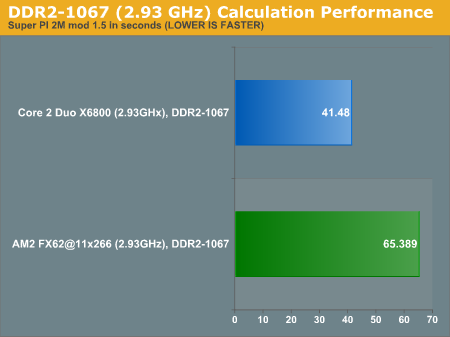
Frankly the gap that remains in Super Pi results when comparing AM2 and Core 2 Duo at the same speed was something of a shock. Clock for clock, with all other variables the same, Core 2 Duo is still almost 60% faster than AM2. There is nothing complex about calculating the value of Pi to 2 million places, but it does show the true power of Conroe in computation-intensive tasks.
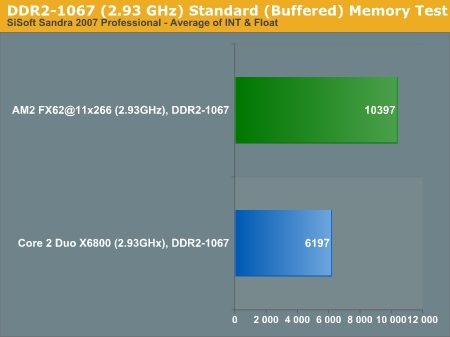
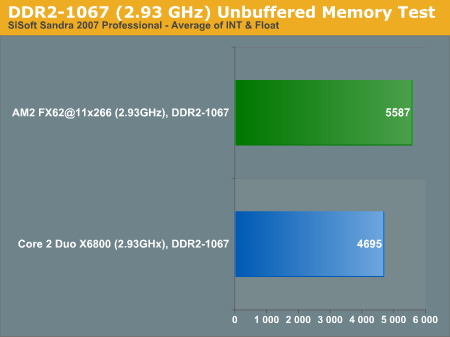
Despite the improvements Intel has made in intelligent read-ahead for memory, AM2 still has a huge lead in buffered memory bandwidth. This is a result of the superior on-processor memory controller used on AM2. The results become much closer in Unbuffered memory results, which is normally more revealing of performance in real-world applications, but AM2 still has a wider memory bandwidth. The unfortunate reality is AM2 is not starved for memory bandwidth and cannot really make effective use of this advantage. AMD clearly knows how to deliver memory bandwidth, so the task now becomes to modify their core logic to make better use of this advantage.
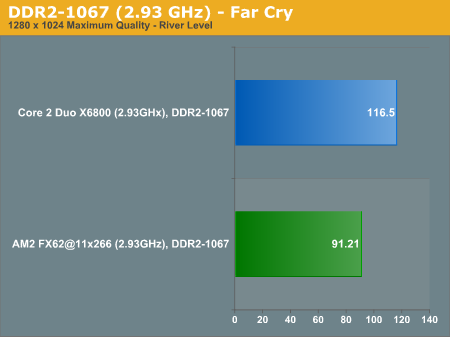
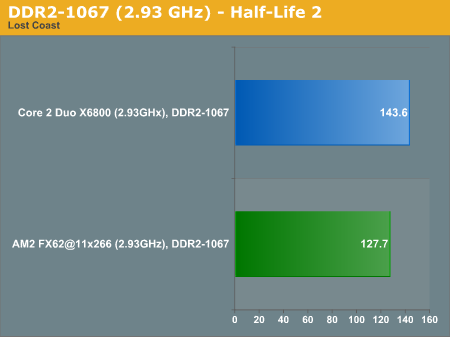
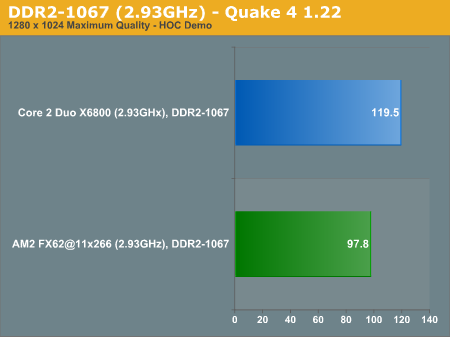
We can now say with authority that Core 2 Duo is the faster performer clock-for-clock across the board. At the same 2.93GHz Far Cry is 27.7% faster, Half-Life 2: Lost Coast is 12.4% faster, and Quake 4 is 22.2% faster on Core 2 Duo. Of course AMD does not currently have a 2.93GHz CPU, so we tested by overclocking FX62. This suggests that FX64, or whatever it will be called, will not help much at 3.0GHz with a 200 clock speed.
It is clear enough that despite the poorer memory bandwidth, Core 2 Duo is the performance leader by a substantial margin at stock speeds. You have seen that in all of the results posted in this article. This conclusion will not satisfy all our readers, however. Many have theorized every incarnation of performance imaginable with AM2 having higher clock speed, higher bandwidth, or higher speed memory than it currently does.
To best answer these questions we put together the fairest comparison we could think of to directly compare Core 2 Duo and AMD AM2. This consists of running both processors at the exact same speed - 2.93GHz - achieved at the same ratios - 11x266. This involves overclocking the AM2 FX62 to 2.93GHz and raising the "bus" speed to 266. That allows an 11x266 ratio to match Core 2 Duo. The desirable side effect is that while AM2 does not really support DDR2-1067, by setting the memory to DDR2-800 we reach DDR2-1067 speed at the 266 speed setting. While this slightly stacks the deck in AMD's favor, it is as close as it is possible to get at running the two systems at the same speed, same memory timings, same memory voltages, same memory, and same video card. We are comparing two identically configured systems with AM2 powering one system and Core 2 Duo powering the other system.
Results are particularly interesting in that the fastest current AM2 processor, the FX62, is overclocked about 5% in CPU speed and 33% in "bus" speed over a stock AM2 system.

Frankly the gap that remains in Super Pi results when comparing AM2 and Core 2 Duo at the same speed was something of a shock. Clock for clock, with all other variables the same, Core 2 Duo is still almost 60% faster than AM2. There is nothing complex about calculating the value of Pi to 2 million places, but it does show the true power of Conroe in computation-intensive tasks.


Despite the improvements Intel has made in intelligent read-ahead for memory, AM2 still has a huge lead in buffered memory bandwidth. This is a result of the superior on-processor memory controller used on AM2. The results become much closer in Unbuffered memory results, which is normally more revealing of performance in real-world applications, but AM2 still has a wider memory bandwidth. The unfortunate reality is AM2 is not starved for memory bandwidth and cannot really make effective use of this advantage. AMD clearly knows how to deliver memory bandwidth, so the task now becomes to modify their core logic to make better use of this advantage.



We can now say with authority that Core 2 Duo is the faster performer clock-for-clock across the board. At the same 2.93GHz Far Cry is 27.7% faster, Half-Life 2: Lost Coast is 12.4% faster, and Quake 4 is 22.2% faster on Core 2 Duo. Of course AMD does not currently have a 2.93GHz CPU, so we tested by overclocking FX62. This suggests that FX64, or whatever it will be called, will not help much at 3.0GHz with a 200 clock speed.










118 Comments
View All Comments
TonyB - Tuesday, July 25, 2006 - link
so ive been hearing a lot of people use this argument, "oh competition is good, i can get a so-and-so cpu now for xyz price!!". what an incredible value!cant you bring that a notch higher and say, "dang, Intel just whooped AMD, i'm going to purchase an amd K6-2 400mhz cpu now for $5" yes! horray for competition! what an incredible value only $5!
at what point does reality set in that you're investing in obsolete technology? or does the old rationale, "i dont want the fastest, this old crap is good enough for me" still apply.
OcHungry - Wednesday, July 26, 2006 - link
You waited 4 years to say that "crap" about AMD's bargain value? but please dont tell us about your 4 years venture in finding a better way to exhust your P4 hot air.very nice.
Calin - Wednesday, July 26, 2006 - link
Unfortunately, the current production processors don't reach that low a value (the AM2 semprons have a price of around $70+, and the Socket A semprons have a price of around $50). You might want to invest in new obsolete technology (with a longer warranty), or you might want to invest in old obsolete technology (or in old current technology, see refurbs).As long as your performance needs are reached, you could be certain to a degree that a failure in your computer could be repaired/replaced in short time, you are ok to go with Pentium MMX or so processors. Anyway, finding SDR RAM for your K6-2 might not be so easy (and SDR DIMMs were a new memory standard then). Good luck finding enough SIMMs to put the memory at 128MB
BPB - Tuesday, July 25, 2006 - link
How about an article spending $200 on both the CPU and video card ($400 total) and then look at what various motherboard and memory combos get me. You could spend $100 to $250 on motherboards and show me what I get, with memory hopefully being the same for the Intel and AMD systems. That's really the bottom line for myself and many, many others. Many if not most of us set a price range for CPU, video card, and memory and then go from there. Either that or simple overall cost is set. I know you give us buying guides where you spend X amount on systems, but I don't think you show us the power each system gets.photoguy99 - Tuesday, July 25, 2006 - link
They already have those articles - They periodically release CPU and Graphics card guides that analyze the bang for the buck at different budgets.BPB - Tuesday, July 25, 2006 - link
I know they do that, but I don't think I've seen both "here's what $1000 gets for an AMD/Intel system" and "here's how fast each system is". That's what I'd like to see. I know how much individual parts cost and how fast they are in and of themselves, but put it all together and show me systems and compare those systems. If they've done that in the past I've missed it. But the past no longer matters, so I'd love to see one that's current as of today's new prices.Calin - Wednesday, July 26, 2006 - link
The computer price guides did just that - taking a budget of $$$ or $$$$ and building systems. There was the budger guide, gamer guide and "all out" guide (this last one had price ranges at $2000+)bob661 - Tuesday, July 25, 2006 - link
What was the purpose of this article? Was there something that was left out of the tons of earlier benchmarks from various websites?bob661 - Tuesday, July 25, 2006 - link
Thanks guys. I don't remember seeing info about memory either.rjm55 - Tuesday, July 25, 2006 - link
There were a lot of things that I hadn't seen anywhere else. No one I have read shows that Conroe is lower in Bandwidth than either AM2 or Netburst. I find that surprising looking at Conroe's big performance lead. This is also the first time I've seen AM2/Conroe compared clock-to-clock in the same configuration using the same memory/settings - and at 2.93GHz. The new graphs for memory speeds show directions and provide more info that bar charts. Suggest you use them more in other reviews.